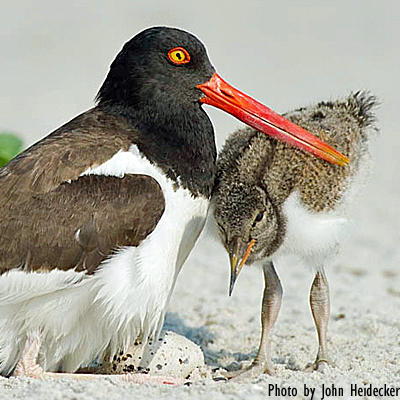The 2016 Nesting Season is wrapping up and the sanctuaries on the Cape Fear River and at Lea-Hutaff Island had a tremendous showing of chicks this summer. By providing specialized habitats for our coastal priority species, the Audubon North Carolina staff contributed to the season of success including banding and census activities to monitor bird populations.
Coastal Nesting at a Glance
This summer, the staff reported 305 Least Tern pairs, 25 American Oystercatcher pairs and seven loggerhead sea turtle nests on Lea-Hutaff island. Along the Cape Fear River, Audubon-managed islands support about one-third of the state’s American Oystercatchers, 65 percent of the state’s White Ibis, and a quarter of the state’s Royal and Sandwich Terns.
In addition to site protection and monitoring, this year staff worked to census American Oystercatchers in the state. Every three years, Audubon North Carolina, the North Carolina Wildlife Resources Commission, and many other partners work together to conduct a state-wide census of nesting oystercatchers. The census, which began in 2004, helps biologists measure the success of management strategies and monitor the heath of oystercatcher populations in the state.
From 2004-2013, the number of oystercatcher pairs nesting at Audubon-managed sites has nearly doubled. This year’s results are still being compiled. Stay tuned this fall for the release of the data!
American Oystercatcher Banding
Banding helps site managers monitor breeding birds and provides demographic and migration data to inform population modeling and habitat preservation. From band resights, we can learn about a bird’s life histories: how long they live, where they nest, and what habitats they use during the non-breeding season.
Statewide partnerships with the North Carolina Coastal Reserve system, Fort Fisher SRA, and Pea Island NWR allowed us to band American Oystercatcher adults and chicks all along the coast. In total, 62 American Oystercatcher adults and chicks were banded.

Fall Migration Is Underway
This fall staff will continue to monitor inlets in Southeast North Carolina for Piping Plovers and other shorebirds. Banded individuals from the endangered Great Lakes Piping Plover population are already returning to winter at Rich Inlet – one of the last remaining natural inlets and a critical habitat for migratory shorebirds in North Carolina.
Preserving Habitats for Coastal Birds
The sanctuary sites managed by Audubon North Carolina staff support about one-third of the coastal waterbirds that nest in the state. Protecting these sites are essential to maintaining healthy populations of coastal birds across the state and the region. Learn more about the Seas & Shores program and find out how you can help more birds thrive.







